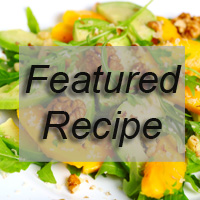Pear and Fresh Date Salad
Serves 3-4
A hearty salad with some savoury grunt and a warm accompaniment can accommodate many seasons. Among its many other nutritional virtues, the carbohydrate content is an important source of water. In addition to the 6-8 cups we need to drink, even more top quality fluid is needed to help produce the astounding 9 litres of digestive juices required daily.
Among some dieters, carbohydrates are less than fashionable. However, the effect they have on the glycemic response, insulin levels, and other weight and vitality factors is not static. It is dependent on the type of carbohydrate eaten, the quantity, and the presence of other foods. Foods such as dates and potatoes for instance, may have a high individual Glycemic Index rating – and thus be dismissed as ‘bad’ by those of limited understanding – but the meal they are part of can easily be low GI and supportive. Health is all about relationship and proportion, and rarely about stark categories of good and evil.
Just one of the low GI contributors in this suggested meal is the protein content. Thanks to Dr Atkins and others, protein regained popular acclaim. But there are numerous other blood sugar regulators whose help can also be enlisted. Top contributors in this recipe there are the oil, lemon juice, fibre and even the crunchiness of the raw ingredients. Together these factors slow the breakdown of all the carbohydrates present into blood sugar or glucose, leading to steady energy and easy appetite control (for more specifics see the GOOD HEALTH SOLUTIONS’ report: You Are Just A Few Steps Away From Peak Vitality).
Protein, fat and carbohydrate: everyone needs these 3 core macronutrients. But we differ – like possessing a unique biochemical fingerprint – in how much of each type is ideal, and which sources suit us best. Use the questionnaire in The Shape Diet to determine your metabolic body type and the key foods that will work for you – or against you. A good starting policy is to eat a variety of wholefoods. Accordingly, this recipe has a list of delicious protein options to choose from.
Serve this tasty and therapeutic dish as a main, along with a bright medley of steamed vegetables: small gourmet potatoes, small whole carrots, and whole green beans (or add asparagus spears in the last 3 minutes of cooking). Toss the hot veg with a spoonful of mild creamy mustard, a splash of avocado oil or lemon juice, fresh or dried dill leaf, and herb salt. Yum.
3 Tbsp chopped fresh parsley
1 Tbsp extra virgin olive oil*
1 Tbsp lemon juice
½ tsp sea salt with kelp*
1 large firm pear, cored and thinly sliced
6 fresh dates, sliced into narrow lengths
½ small red pepper, thinly sliced
***
1 Tbsp extra virgin olive oil*
1 medium red onion, thinly sliced into rounds
lots of freshly ground pepper
choice of Protein Option as below
***
2 cups mixed torn lettuce and baby greens
Whisk together the parsley, 1 Tbsp olive oil, lemon juice and salt. Mix with the pear, dates and red pepper. Cover and set aside.
Pour 1 Tbsp olive oil into a fry pan over low heat. Add the onion (and Protein Option if cooking is required) and sprinkle generously with pepper. Cook 3 minutes or more until lightly cooked. Remove from heat.
Add all the contents of the pan to the pear mixture. Immediately before serving, add the greens and toss.
Protein Options
Choose one of the following and add as indicated:
· 6 Tbsp cashews, pinenuts, pistachios, chopped macadamias, or slivered almonds; 6 sliced Swiss Brown mushrooms, plus ½ tsp Chinese 5 spice, ½ tsp garam masala and ¼ tsp kelp granules (fry with onions).
· 1/2 cup small cubes of tofu or strips of tempeh, 1 tsp curry powder (fry with onions, then add 1 Tbsp soy sauce*).
· 3/4 cup fresh or thawed squid rings or prawns, or small slices fresh fish, plus sesame seeds and seasoned salt (fry with onions).
· 1/2 cup thin strips of venison or lamb, plus 2 tsp cumin powder (fry with onions, then add 1 Tbsp soy sauce*).
· 1/2 cup smoked fish (add to pear mixture).
· Slices of 2-3 egg omelet, or wedges of 2-3 hard-boiled eggs (sprinkle with seasoned salt and add to pear mixture).
Shopping and Preparation Tips*
• Olive Oil: Extra virgin olive oil is achieved by using cold mechanical pressure rather than the high heat and chemical solvents typical to most supermarket oils. These practices damage oils and the people who eat them. For information on which fats to choose for which purpose and why, see my article on the TIPS page: The Fats of Life.
• Sea salt: is simply sea water dehydrated by the sun. When mixed with a little seaweed (containing iodine and other minerals low in our soil) it is ideal in terms of flavour (interesting but not too strong) and mineral balance. Try Pacific Harvest or Malcolm Harker brands. Both are in health stores and gourmet stores. Ordinary salt is taken from mines or the sea and so highly refined over extreme heat that it contains nothing but sodium chloride. All other minerals have been stripped away. These minerals such as potassium and magnesium naturally help regulate fluid balance, blood pressure and other related concerns. Other chemicals may be added to table salt to prevent clumping and the salt may be bleached.
• Soy sauce: can be a fake, unfermented chemical concoction of caramel colouring, artificial additives, wheat and cheap salt. True soy sauce contains nothing artificial and is naturally brewed for two to three years. It is made by fermenting soybeans with the help of a healthful mould (similar in concept to making yoghurt or cheese); a little roasted grain – usually wheat or barley – for flavour and to speed fermentation, plus added salt. ‘Shoyu’ is the Japanese word for true fermented soy sauce. ‘Tamari’ also describes naturally brewed soy sauce but one which does not contain wheat or other grain. In the supermarket look for the organic Ceres brand, or the plain only Kikkoman (their other varieties usually contain artificial additives including MSG – see TIPS).



